Empirical Analysis of the Impact of COVID-19 Social Distancing on Residential Electricity Consumption Based on Demographic Characteristics and Load Shape
Abstract
:1. Introduction
2. Data and Description
3. Methods for Analysis of the Impact of Social Distancing on Household Energy Consumption
3.1. The Method for Estimating the Impact of Social Distancing Using Household Energy Consumption Model
3.2. The Method for Hybrid-Imputation Model for Missing Data
3.3. The Method for Clustering of Household Load Shape
3.4. Procedure of Proposed Method
4. Empirical Results
4.1. Results of Hybrid Imputation and Clustering of Household Load Shape
4.2. Empirical Results for Impact of Social Distancing in Korea
5. Discussion
6. Conclusions
Author Contributions
Funding
Institutional Review Board Statement
Informed Consent Statement
Data Availability Statement
Acknowledgments
Conflicts of Interest
References
- WHO Website. 2021. Available online: https://covid19.who.int/ (accessed on 1 January 2021).
- Pillay, A. COVID-19 Crisis: Lockdown Knocks Power Use down 20–40% in Some Cities. The Business Standard. 19 June 2020. Available online: https://www.business-standard.com/article/economy-policy/lockdown-knocked-power-consumption-down-by-up-to-40-in-large-cities-120061800951_1.html (accessed on 21 January 2021).
- IEA. International Energy Agency, COVID-19 Impact on Electricity. 2021. Available online: https://www.iea.org/reports/covid-19-impact-on-electricity (accessed on 21 January 2021).
- ETEnergyWorld. Worldwide Lockdowns to Reduce Nuclear Power Output by 3 Per Cent in 2020. 1 May 2020. Available online: https://energy.economictimes.indiatimes.com/news/power/worldwide-lockdowns-to-reduce-nuclear-power-output-by-3-per-cent-in-2020/75493688 (accessed on 9 January 2021).
- Meinrenken, C.J.; Modi, V.; Mckeown, K.R.; Culligan, P.J. New Data Suggest COVID-19 Is Shifting the Burden of Energy Costs to Households. 21 April 2020. Available online: https://news.climate.columbia.edu/2020/04/21/covid-19-energy-costs-households/ (accessed on 1 February 2021).
- Times, T.E. India’s Power Consumption Shrinks 9.24% at 100.13 BU in March 2020. 2020. Available online: https://economictimes.indiatimes.com/industry/energy/power/indias-power-consumption-shrinks-9-24-at-100-13-bu-in-march/re_show/74933363.cms (accessed on 1 February 2021).
- IESO. Reliability Outlook: An Adequacy Assessment of Ontario’s Electricity System from October 2020 to March 2022. September 2020. Available online: https://www.ieso.ca/en/Sector-Participants/Planning-and-Forecasting/Reliability-Outlook (accessed on 17 February 2021).
- Aruga, K.; Islam, M.; Jannat, A. Effects of COVID-19 on Indian energy consumption. Sustainability 2020, 12, 5616. [Google Scholar] [CrossRef]
- Pesaran, M.H.; Shin, Y.; Smith, R.J. Bounds testing approaches to the analysis of level relationships. J. Appl. Econom. 2001, 16, 289–326. [Google Scholar] [CrossRef]
- Chhetri, R. Effects of COVID-19 pandemic on household energy consumption at College of Science and Technology. Energies 2020, 3, 1383–1387. [Google Scholar]
- Carvalho, M.; Bandeira de Mello Delgado, D.; de Lima, K.M.; de Camargo Cancela, M.; dos Siqueira, C.A.; de Souza, D.L.B. Effects of the COVID-19 pandemic on the Brazilian electricity consumption patterns. Int. J. Energy Res. 2021, 45, 3358–3364. [Google Scholar] [CrossRef]
- Lusis, P.; Khalilpour, K.R.; Andrew, L.; Liebman, A. Short-term residential load forecasting: Impact of calendar effects and forecast granularity. Appl. Energy 2017, 205, 654–669. [Google Scholar] [CrossRef]
- Fan, S.; Methaprayoon, K.; Lee, W.-J. Multiregion load forecasting for system with large geographical area. IEEE Trans. Ind. Appl. 2009, 45, 1452–1459. [Google Scholar] [CrossRef]
- Krarti, M.; Aldubyan, M. Review analysis of COVID-19 impact on electricity demand for residential buildings. Renew. Sustain. Energy Rev. 2021, 143, 110888. [Google Scholar] [CrossRef]
- Snow, S.; Bean, R.; Glencross, M.; Horrocks, N. Drivers behind residential electricity demand fluctuations due to COVID-19 restrictions. Energies 2020, 13, 5738. [Google Scholar] [CrossRef]
- Bielecki, S.; Skoczkowski, T.; Sobczak, L.; Buchoski, J.; Maciąg, Ł.; Dukat, P. Impact of the Lockdown during the COVID-19 Pandemic on Electricity Use by Residential Users. Energies 2021, 14, 980. [Google Scholar] [CrossRef]
- Gostic, K.M.; McGough, L.; Baskerville, E.B.; Abbott, S.; Joshi, K.; Tedijanto, C.; Kahn, R.; Niehus, R.; Hay, J.A.; De Salazar, P.M.; et al. Practical considerations for measuring the effective reproductive number, Rt. PLoS Comput. Biol. 2020, 16, e1008409. [Google Scholar] [CrossRef]
- Yoo, M.S.; Kim, Y.J.; Baek, S.J.; Kwon, D.H. The concept of reproduction number and changes according to government response policies. Wkly Health Dis. 2020, 14, 282–289. [Google Scholar]
- Liu, S.; Kong, G.; Kong, D. Effects of the COVID-19 on air quality: Human mobility, spillover effects, and city connections. Environ. Resour. Econ. 2020, 76, 635–653. [Google Scholar] [CrossRef] [PubMed]
- He, P.; Liang, J.; Qiu, Y.L.; Li, Q.; Xing, B. Increase in domestic electricity consumption from particulate air pollution. Nat. Energy 2020, 5, 985–995. [Google Scholar] [CrossRef]
- Eom, J.; Hyun, M.; Lee, J.; Lee, H. Increase in household energy consumption due to ambient air pollution. Nat. Energy 2020, 5, 976–984. [Google Scholar] [CrossRef]
- Li, Y.; Pizer, W.A.; Wu, L. Climate change and residential electricity consumption in the Yangtze River Delta, China. Proc. Natl. Acad. Sci. USA 2019, 116, 472–477. [Google Scholar] [CrossRef] [PubMed] [Green Version]
- Ito, K. Do consumers respond to marginal or average price? Evidence from nonlinear electricity pricing. Am. Econ. Rev. 2014, 104, 537–563. [Google Scholar] [CrossRef] [Green Version]
- Peppanen, J.; Zhang, X.; Grijalva, S.; Reno, M.J. Handling bad or missing smart meter data through advanced data imputation. In Proceedings of the 2016 IEEE Power & Energy Society Innovative Smart Grid Technologies Conference (ISGT), Minneapolis, MN, USA, 6–9 September 2016. [Google Scholar]
- Borges, C.E.; Kamara-Esteban, O.; Castillo-Calzadilla, T.; Andonegui, C.M.; Alonso-Vicario, A. Enhancing the missing data imputation of primary substation load demand records. Sustain. Energy Grids Netw. 2020, 23, 100369. [Google Scholar] [CrossRef]
- Ferrenberg, A.M.; Swendsen, R.H. Optimized Monte Carlo data analysis. Comput. Phys. 1989, 3, 101–104. [Google Scholar] [CrossRef] [Green Version]
- Jang, M.; Jeong, H.C.; Kim, T.; Joo, S. Load Profile-Based Residential Customer Segmentation for Analyzing Customer Preferred Time-of-Use (TOU) Tariffs. Energies 2021, 14, 6130. [Google Scholar] [CrossRef]
- Tran, D.H.; Luong, D.-L.; Chou, J.-S. Nature-inspired metaheuristic ensemble model for forecasting energy consumption in residential buildings. Energy 2020, 191, 116552. [Google Scholar] [CrossRef]
- Chicco, G.; Napoli, R.; Piglione, F. Comparisons among clustering techniques for electricity customer classification. IEEE Trans. Power Syst. 2006, 21, 933–940. [Google Scholar] [CrossRef]
- Zhang, Y.; Chen, W.; Xu, R.; Black, J. A cluster-based method for calculating baselines for residential loads. IEEE Trans. Smart Grid 2015, 7, 2368–2377. [Google Scholar] [CrossRef]
- Saputra, D.M.; Saputra, D.; Oswari, L.D. Effect of distance metrics in determining k-value in k-means clustering using elbow and silhouette method. In Sriwijaya International Conference on Information Technology and Its Applications; SICONIAN.; Atlantis Press: Padang, Indonesia, 2020; pp. 341–346. Available online: https://www.atlantis-press.com/proceedings/siconian-19/125939938 (accessed on 1 November 2021).
- Zeng, J.; Wang, J.; Guo, L.; Fan, G.; Zhang, K.; Gui, G. Cell scene division and visualization based on autoencoder and k-means algorithm. IEEE Access 2019, 7, 165217–165225. [Google Scholar] [CrossRef]
- Jeong, H.C.; Jang, M.; Kim, T.; Joo, S.-K. Clustering of load profiles of residential customers using extreme points and demographic characteristics. Electronics 2021, 10, 290. [Google Scholar] [CrossRef]
- Davis, L.W.; Gertler, P.J. Contribution of air conditioning adoption to future energy use under global warming. Proc. Natl. Acad. Sci. USA 2015, 112, 5962–5967. [Google Scholar] [CrossRef] [PubMed] [Green Version]
- Nair, G.; Gustavsson, L.; Mahapatra, K. Factors influencing energy efficiency investments in existing Swedish residential buildings. Energy Policy 2010, 38, 2956–2963. [Google Scholar] [CrossRef]
- Liang, J.; Liu, P.; Qiu, Y.; Wang, Y.D.; Xing, B. Time-of-use electricity pricing and residential low-carbon energy technology adoption. Energy J. 2020, 41. Available online: https://www.iaee.org/energyjournal/article/3500 (accessed on 21 February 2021). [CrossRef]
- Kang, H.; An, J.; Kim, H.; Ji, C.; Hong, T.; Lee, S. Changes in energy consumption according to building use type under COVID-19 pandemic in South Korea. Renew. Sustain. Energy 2021, 148, 111294. [Google Scholar] [CrossRef]
- Cvetković, D.; Nešović, A.; Terzić, I. Impact of people’s behavior on the energy sustainability of the residential sector in emergency situations caused by COVID-19. Energy Build. 2021, 230, 110532. [Google Scholar] [CrossRef] [PubMed]
- Rouleau, J.; Gosselin, L. Impacts of the COVID-19 lockdown on energy consumption in a Canadian social housing building. Appl. Energy 2021, 287, 116565. [Google Scholar] [CrossRef] [PubMed]
- Qarnain, S.S.; Muthuvel, S.; Bathrinath, S. Review on government action plans to reduce energy consumption in buildings amid COVID-19 pandemic outbreak. Mater. Today Proc. 2021, 45, 1264–1268. [Google Scholar] [CrossRef] [PubMed]

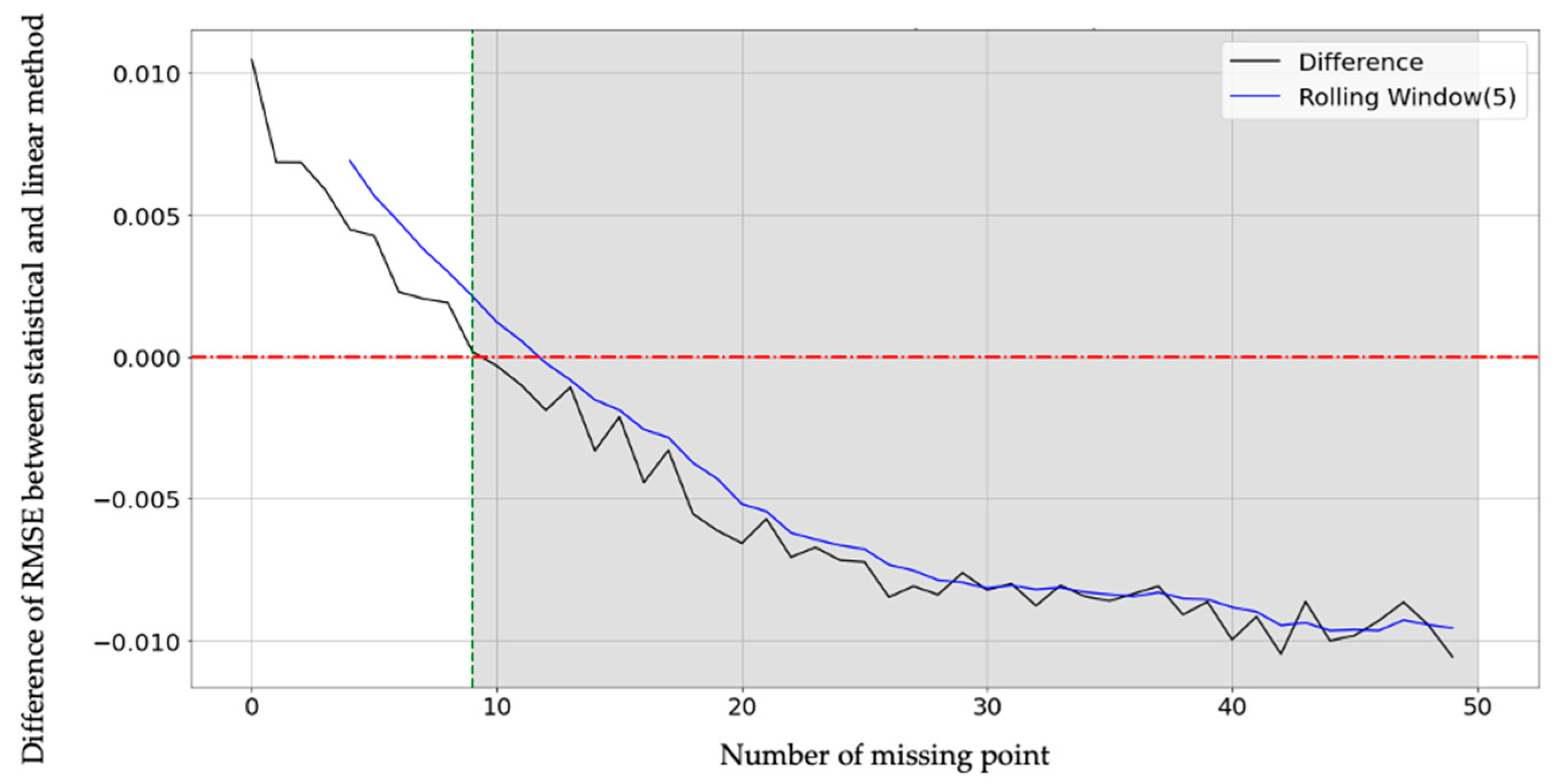
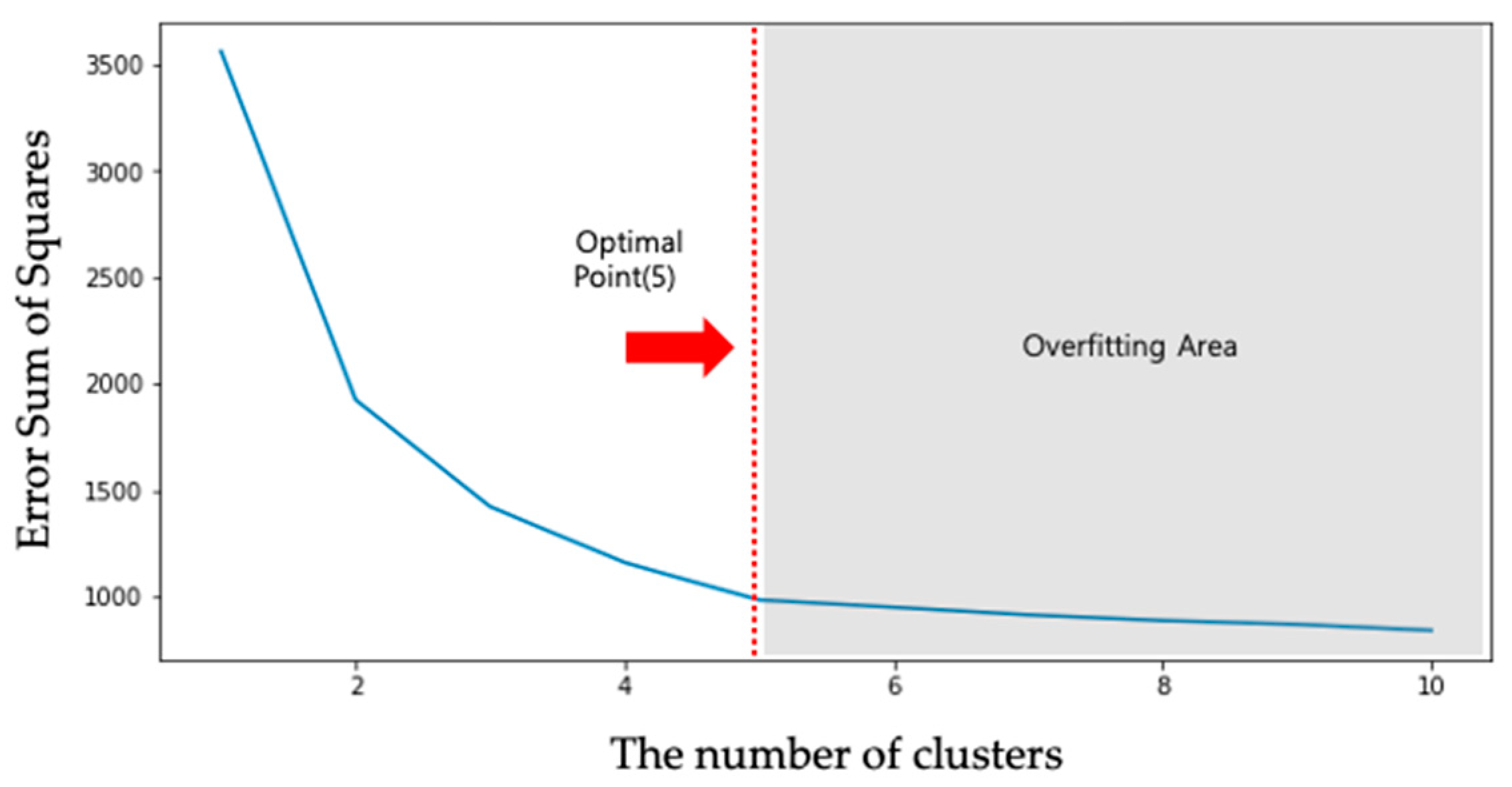
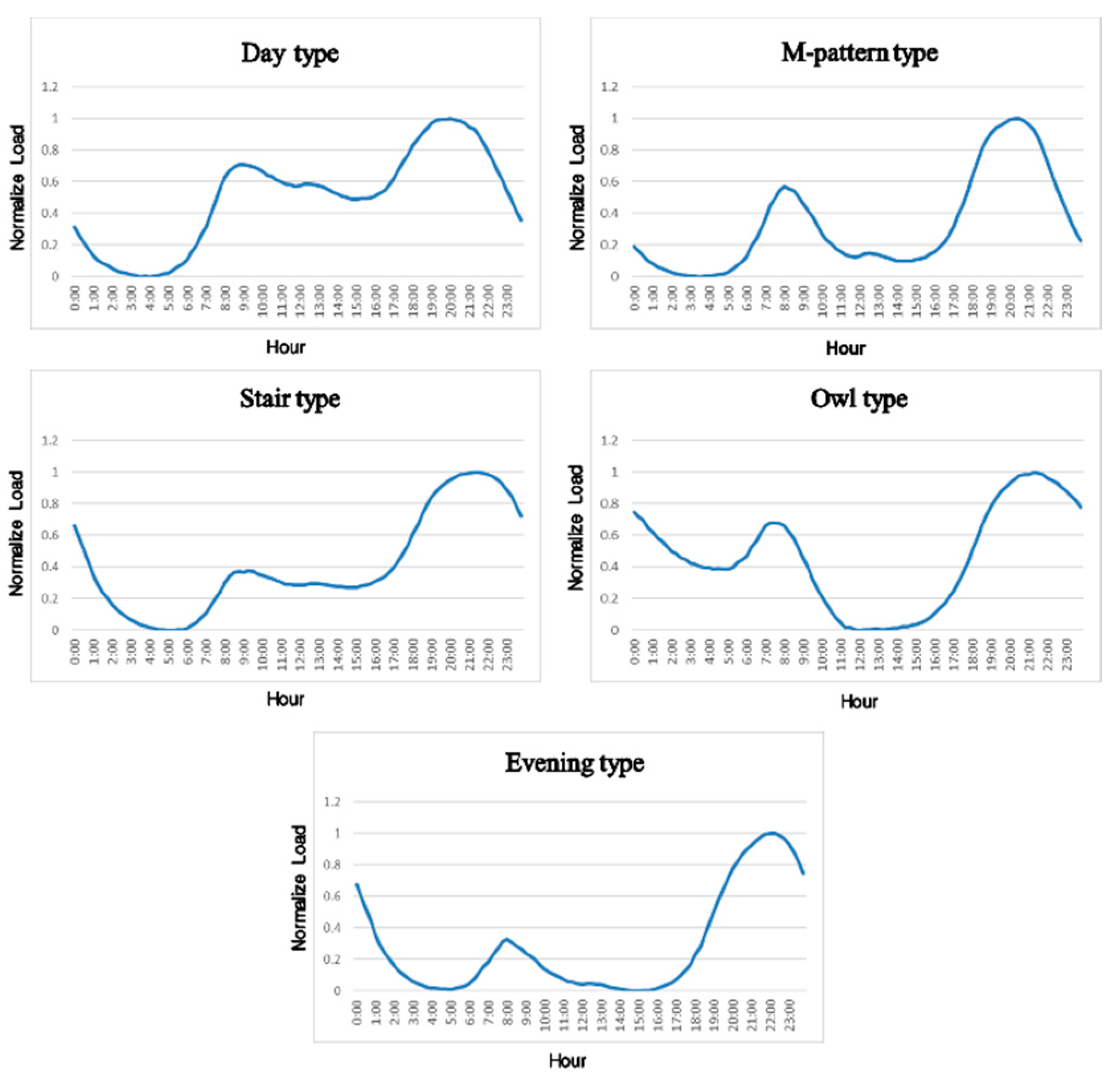
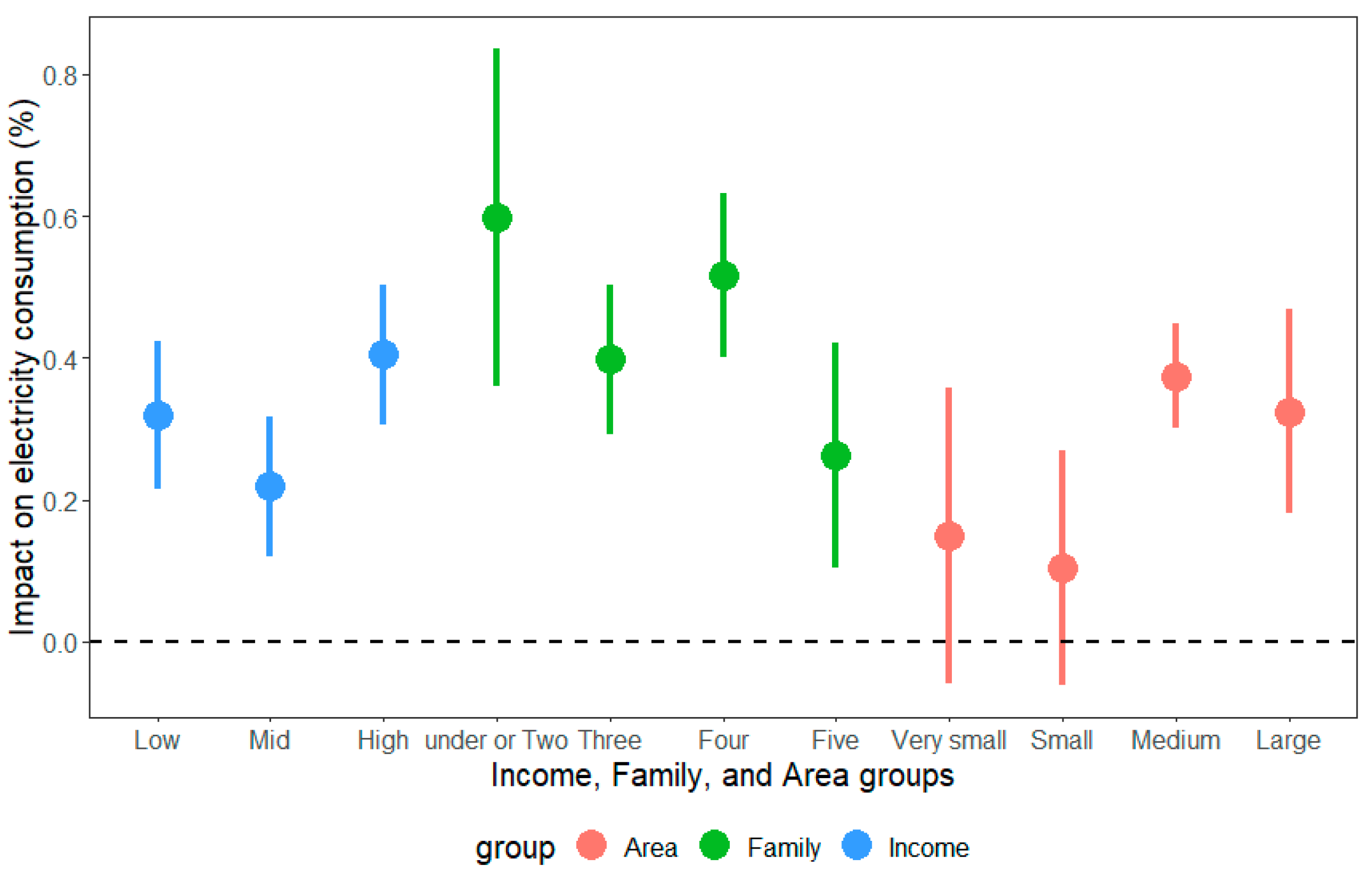
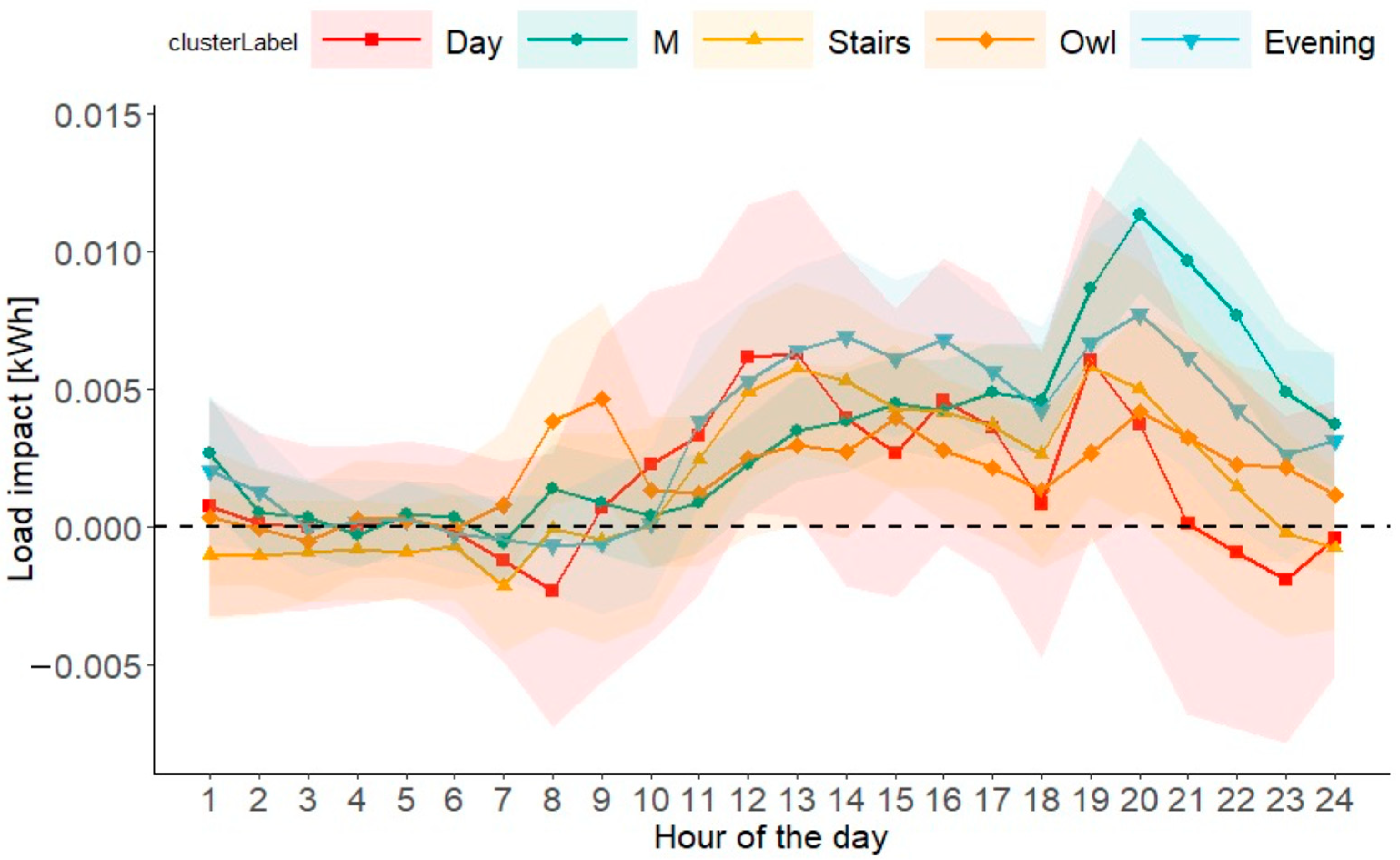
| Week Index on 2020 | Rj | Issue |
|---|---|---|
| 6 (2.2–2.8) | 1.5 | |
| 7 (2.9–2.15) | 0.81 | |
| 8 (2.16–2.22) | 9.35 | 1st regional infection in Daegu, Gyeongbuk (2.20–2.29) |
| 9 (2.23–2.29) | 5.66 | |
| 10 (3.1–3.7) | 1.94 | First social distancing (2.29–3.21) |
| 11 (3.8–3.14) | 0.67 | |
| 12 (3.15–3.21) | 0.45 | |
| 13 (3.22–3.28) | 0.76 | Strengthened national social distancing (3.22–4.19) |
| 14 (3.29–4.4) | 0.85 | |
| 15 (4.5–4.11) | 0.67 | |
| 16 (4.12–4.18) | 0.53 | |
| 17 (4.19–4.25) | 0.58 | |
| 18 (4.26–5.2.) | 0.59 |
| Variable | Unit | Mean | Standard Deviation | Min | Max | Observation 1 |
|---|---|---|---|---|---|---|
| Use | kWh | 0.039 | 0.67 | 0.003 | 6.81 | 3,290,232 |
| Temp | °C | 6.09 | 6.13 | −13 | 26.8 | 3,290,232 |
| Humid | % | 59.7 | 22.4 | 4 | 100 | 3,290,232 |
| Price | KRW/kWh | 99.5 | 13.6 | 93.3 | 234.5 | 3,290,232 |
| Characteristic | Unit | Description | Percentage |
|---|---|---|---|
| Income | KRW | ≤2.4 million | 24% |
| 2.41–5.50 million | 48% | ||
| ≥5.51 million | 28% | ||
| Family member | person | ≤Two | 38% |
| Three | 24% | ||
| Four | 28% | ||
| ≥Five | 10% | ||
| House area | m2 | 33.1–62.8 (i.e., very small) | 7% |
| 66.1–95.6 (i.e., small) | 21% | ||
| 99.2–128.9 (i.e., medium) | 54% | ||
| ≥132.2 (i.e., large) | 18% |
| Dependent Variable: ln (Use) | |||
|---|---|---|---|
| M1 | M2 | M3 | |
| Rj | 0.004 *** | 0.003 *** | 0.003 *** |
| (0.0003) | (0.0003) | (0.0003) | |
| temp | −0.002 *** | −0.0004 ** | −0.001 *** |
| (0.0002) | (0.0002) | (0.0002) | |
| temp2 | 0.00001 | 0.00002 | 0.00002 ** |
| (0.00001) | (0.00001) | (0.00001) | |
| humid | 0.001 *** | 0.001 *** | 0.001 *** |
| (0.00003) | (0.00003) | (0.00003) | |
| holiday | 0.008 ** | 0.022 *** | 0.023 *** |
| (0.004) | (0.003) | (0.003) | |
| price | 0.0005 *** | −0.001 *** | −0.001 *** |
| (0.0001) | (0.00005) | (0.00004) | |
| Individual fixed effect | household-level | household-month level | household-month-weekday level |
| Time fixed effect | weekday-hour | weekday-hour | weekday-hour |
| Observations | 3,289,907 | 3,289,907 | 3,289,907 |
| R-squared | 0.453 | 0.495 | 0.503 |
| Adjusted R-squared | 0.453 | 0.495 | 0.501 |
Publisher’s Note: MDPI stays neutral with regard to jurisdictional claims in published maps and institutional affiliations. |
© 2021 by the authors. Licensee MDPI, Basel, Switzerland. This article is an open access article distributed under the terms and conditions of the Creative Commons Attribution (CC BY) license (https://creativecommons.org/licenses/by/4.0/).
Share and Cite
Jang, M.; Jeong, H.C.; Kim, T.; Suh, D.H.; Joo, S.-K. Empirical Analysis of the Impact of COVID-19 Social Distancing on Residential Electricity Consumption Based on Demographic Characteristics and Load Shape. Energies 2021, 14, 7523. https://doi.org/10.3390/en14227523
Jang M, Jeong HC, Kim T, Suh DH, Joo S-K. Empirical Analysis of the Impact of COVID-19 Social Distancing on Residential Electricity Consumption Based on Demographic Characteristics and Load Shape. Energies. 2021; 14(22):7523. https://doi.org/10.3390/en14227523
Chicago/Turabian StyleJang, Minseok, Hyun Cheol Jeong, Taegon Kim, Dong Hee Suh, and Sung-Kwan Joo. 2021. "Empirical Analysis of the Impact of COVID-19 Social Distancing on Residential Electricity Consumption Based on Demographic Characteristics and Load Shape" Energies 14, no. 22: 7523. https://doi.org/10.3390/en14227523
APA StyleJang, M., Jeong, H. C., Kim, T., Suh, D. H., & Joo, S.-K. (2021). Empirical Analysis of the Impact of COVID-19 Social Distancing on Residential Electricity Consumption Based on Demographic Characteristics and Load Shape. Energies, 14(22), 7523. https://doi.org/10.3390/en14227523







